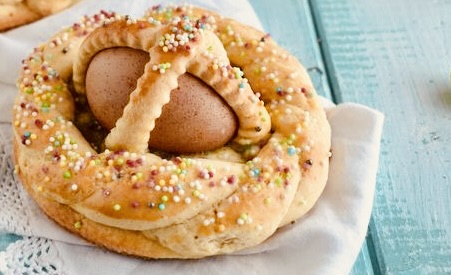Easter is a special time of year, and in many cultures, it is celebrated with a variety of traditional foods.
The whole Egg is the main ingredient
A powerful symbol of new life, growth, and renewal. Whether used in Christian or other traditions, it represents the promise of hope and the potential for transformation, making it a fitting symbol for the Easter season. So interesting to find different declinations that are always the symbol of a positive future message. This is why must be a whole egg, also a symbol of fertility and new life important the visual function to stay whole.
Just to have an idea, here is a list of easter pastries that uses the whole egg in it:
- Greek Easter Bread (Tsoureki): A sweet bread recipe that includes a boiled red-dyed egg, which is often placed in the center of the loaf.
- Italian Easter Bread (Pane di Pasqua): A sweet bread recipe that includes a boiled egg, which is often wrapped in dough and baked into the loaf.
- Russian Kulich: A tall, cylindrical sweet bread recipe that includes boiled eggs, which are often placed on top of the dough before baking.
- Croatian Pinca: A sweet bread recipe that includes boiled eggs, which are often placed on top of the loaf before baking.
- Romanian Pasca: A sweet bread recipe that includes boiled eggs, which are often used as a decorative topping.
- Colombian Easter Bread (Mona de Pascua): A sweet bread recipe that includes boiled eggs, which are often placed on top of the dough in a circular pattern.
- Portuguese Easter Bread (Folar de Pascoa): A sweet bread recipe that includes boiled eggs, which are often placed in the center of the loaf.
- Maltese Figolli: A sweet pastry recipe that includes a boiled egg, which is often placed in the center of the cookie before baking.
- Mexican Capirotada: A traditional bread pudding recipe that includes boiled eggs, which are often sliced and layered into the dish.
- Finnish Easter Pasha (Pashka): A sweet cheese recipe that includes boiled eggs, which are often placed on top of the finished product as a decoration.
The basket with the egg inside in Sicilian Pastry
Can be a basket or a crown or a bird. All of them carry the precious symbol inside.
Maybe “panaru (the basket) con l’uovo”, the sweet pastry, is the most famous in Sicily.
This dessert is made with a rich, buttery dough and has a long history in Sicily. Maybe the town of Modica plays a role in the origin but anyway all of Sicily and a big part of the south of Italy have this dessert in their Easter tradition. A whole egg is inside as symbol of fertility and new life. But now, let’s make it:
Ingredients:
- 4 cups all-purpose flour
- 1 cup sugar
- 1 cup unsalted butter, softened
- 4 eggs
- 1 whole egg, raw
- 1/2 cup warm milk
- 1 tsp vanilla extract
- 1 tsp salt
- 1 tbsp active dry yeast
- Powdered sugar, for dusting
Instructions:
- In a large bowl, combine the flour, sugar, and salt.
- In a separate bowl, mix the yeast with the warm milk and let sit for 5 minutes.
- Add the butter, eggs, vanilla extract, and yeast mixture to the flour mixture and knead until a smooth dough forms.
- Cover the bowl with a clean towel and let the dough rise in a warm, draft-free place for 2 hours.
- Preheat the oven to 350°F.
- Divide the dough into 12 equal pieces and shape each piece into a ball.
- Roll out each ball into a circle and place a whole raw egg in the center.
- Fold the edges of the dough up and around the egg to create a pouch, pinching the edges to seal.
- Place the panari on a baking sheet lined with parchment paper and let rise for 30 minutes.
- Bake the panari for 25-30 minutes or until golden brown.
- Remove from the oven and let cool completely.
- Dust with powdered sugar before serving.
Conclusion: U panaru con l’uovo is a delicious Easter treat that is easy to make and perfect for sharing with friends and family. With its rich, buttery dough and surprise egg filling, it is sure to become a new favorite in your household. So why not give this traditional Sicilian dessert a try this Easter and enjoy a taste of Italy right at home?

